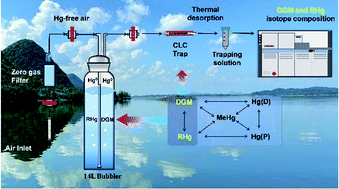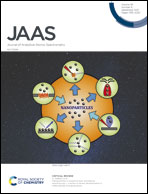Extraction of ultratrace dissolved gaseous mercury and reactive mercury in natural freshwater for stable isotope analysis†
Abstract
Dissolved gaseous mercury (DGM) and reactive mercury (RHg) are important mercury (Hg) forms in natural water bodies. Knowledge of the concentration levels and isotope compositions of DGM and RHg in aquatic ecosystems is of crucial importance for understanding the fate of Hg and Hg cycle. In this study, we developed a method to preconcentrate the ultratrace levels of DGM and RHg in freshwater for stable isotope analysis. In this method, 10 L of amended water (or after addition of acidic SnCl2) was purged for 2 hours with Hg-free air gas at 4 L min−1, and the Hg(0) product was then collected onto a chlorine-impregnated activated carbon (CLC) trap. This process was repeated for a total of 80 L water for DGM collection or 40 L of water for RHg collection in order to obtain sufficient DGM and RHg amounts for isotope analysis. DGM and RHg collected on CLC traps were then thermally desorbed and further preconcentrated into 40% acid-trapping solutions for stable isotope analysis using cold vapor multicollector-inductively coupled plasma-mass spectrometry (CV-MC-ICPMS). The method was evaluated by laboratory tests using additions of certified Hg(0) and Hg(II) references with known concentrations and isotopic compositions as well as field measurements of duplicate samples. The laboratory tests showed that 98.1 ± 8.1% of DGM (1sd, ranging from 85.1 to 115.9%, n = 14) and 98.7 ± 8.7% of RHg (81.3 to 122%, n = 33) could be extracted from freshwater, and the isotopic compositions of the extracted Hg(0) and Hg(II) agreed well with the injected Hg(0) and Hg(II) references (paired sample T test: p values ≥ 0.20 for all Hg isotope signatures). Based on the results from the laboratory tests, we propose the expanded uncertainty (2sd) of δ202Hg, Δ199Hg, and Δ200Hg to be 0.28‰, 0.07‰, and 0.07‰, respectively, for DGM isotope analysis, and 0.25‰, 0.07‰, and 0.07‰, respectively, for RHg isotope analysis. The duplicate field tests showed negligible differences in DGM and RHg isotopic compositions between the paired samples. These results demonstrate that the extraction method can accurately measure DGM and RHg isotopic compositions in freshwater, providing a useful tool for investigating Hg at ultratrace levels in an aquatic environment.



 Please wait while we load your content...
Please wait while we load your content...